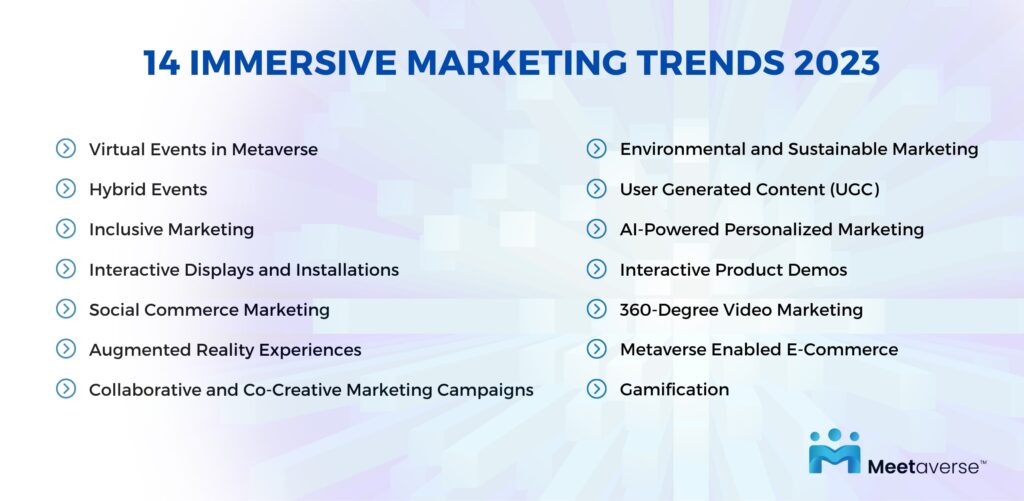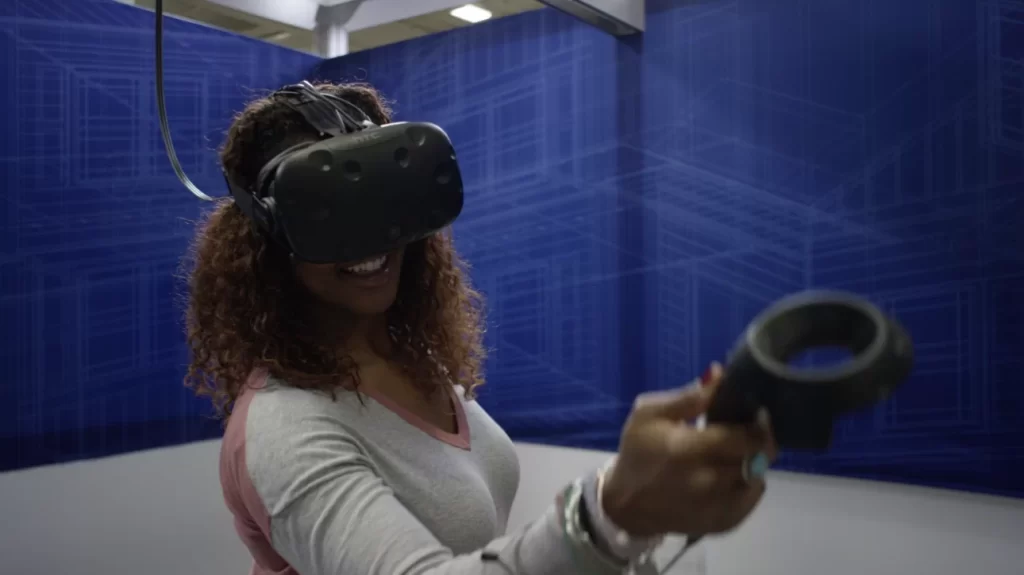Metaverse platforms are taking immersive branding strategies to the next level – read on for inspiration about how to make this new tech environment work for you.
What is an Immersive Experience
An immersive experience is an engagement that fully captivates our senses and transports us into a different world or reality, blurring the boundaries between the physical and digital realms. It creates a deeply engaging and memorable encounter that allows us to escape, explore, and interact with a simulated environment.
Evolving digital marketing is witnessing a transformation as businesses explore new avenues to engage target audiences. With a smooth transition into the metaverse, digital marketing is poised to revolutionize the way brands interact with customers, offering immersive marketing experiences that transcend traditional marketing boundaries.
What is Immersive Marketing?
Immersive marketing helps brands build deep and lasting connections with their consumers by tapping into customer emotions and values. Immersive marketing experiences go beyond traditional marketing by creating interactive and captivating encounters that deeply engage consumers.
Examples of immersive marketing include virtual reality tours of a hotel or venue, augmented reality apps that allow users to visualize products in their own homes, and interactive installations that offer hands-on brand experiences.
The metaverse is a transformative platform for immersive marketing experiences, enabling brands to create interconnected virtual environments where consumers can engage, explore, and interact with their products and services in unprecedented ways. As the concept of the metaverse continues to unfold, understanding its immersive experience meaning is a common endeavor.
If you find yourself in the early stages of exploring the metaverse’s workings, rest assured that you’re not alone. Brands are increasingly embracing metaverse marketing, leveraging its technology to enhance trending immersive marketing approaches that foster brand attachment and drive higher conversion rates. How? Let’s explore together!
14 Immersive Marketing Trends 2023

1. Collaborative and Co-Creative Marketing Campaigns
Brands can involve their audience in marketing campaigns to build a sense of community and ownership. Encouraging influencers to participate in product vision campaigns is a surefire way to establish enduring brand connections.
Nike’s pioneering .SWOOSH Web3 platform invites customers to buy and trade virtual Nike products, join in community challenges for the chance to net exclusive access to events and gain access to new product drops, and even co-create Nike designs.
In crowdsourcing campaigns, brands involve their audiences in the decision-making by soliciting ideas, feedback, and suggestions. For instance, a beverage company might launch a crowdsourcing campaign to ask consumers to submit ideas for a new flavour, allowing them to actively participate in the creation and marketing of the product. Interactive metaverse spaces with 3D graphics offer endless opportunities for co-creation and collaboration and build emotional investment in brand affiliation.
2. User Generated Content (UGC)
When someone engages with your brand by creating or commenting on a post, it introduces you to that person’s social network. The Starbucks White Cup Contest invited customers to decorate their white cups and tag their posts with #WhiteCupContest.
The result was a shared space of creativity, with thousands of visually striking posts that amplified the brand’s social presence.
The many options for co-creation and collaboration enabled by metaverse platforms, make the metaverse ideal for engaging target audiences to produce user generated content, submit designs for metaverse avatar components or virtual merchandise.
3. Gamification
One of the most powerful ways humans engage with one another is through play, and gamification has become a key pillar of immersive marketing strategy. As anyone who’s played Pokemon Go will agree, augmented and virtual reality offer brands the opportunity to bring intentional communities together through curiosity, challenge, and fun.
Brands can offer potential customers access to exclusive content and exclusive products as an incentive to play and build interest in their offerings.
Marketers ensure that the digital challenges are designed to allow users the ability to participate and have multiple chances to win or achieve success, while maintaining a healthy level of competition.
4. Interactive Product Demos

Digitally augmented product demos are poised to change the face of shopping as we know it now. Augmented reality tech allows brands to provide additional information and supplementary content when interacting with a physical object, while virtual reality and 360 degree video makes it possible to interact with a product in a totally virtual space.
Virtual reality experiences like the Lowes Holoroom take interactive product demoing one step further by providing VR-enabled instruction on diy home renovation skills, attracting customers to their store and motivating them to purchase the products they’ve had a chance to test out virtually on-site.
Meetaverse offers similar functionality without requiring specialized equipment via 3D interactive displays.
5. Virtual Events in Metaverse
The future of immersive brand experience events definitely includes the metaverse. Attendees can engage with a whole set of immersive marketing techniques, while avoiding the carbon costs of in-person attendance. Additionally, dedicated virtual environments can remain active after an event’s conclusion to encourage evergreen engagement with sponsors and stakeholders.
Sephora took their virtual event presence beyond the webinar when they partnered with Meetaverse to produce Unwind With Beauty, a virtual event featuring daily interactive live events and a photo booth.
6. Hybrid Events
While hybrid events have emerged as a result of recent technological advancements, participants attending solely through virtual means have struggled to truly feel connected with the group. The potential of metaverse technology offers hope in addressing this challenge.
Remote attendees can more fully participate through immersive experience metaverse as opposed to viewing live streaming events on their screen.
7. Inclusive Marketing
Inclusive marketing is a strategic approach that aims to create campaigns and messages that resonate with diverse audiences, promoting representation, equality, and inclusivity.
The interactive and participatory nature of metaverse environments makes them a natural fit for inclusive marketing pushes, as Clinique’s Metaverse More Like Us campaign demonstrates. Diverse makeup artists partnered with Clinique and Daz 3D to create an NFT makeup collection celebrating diversity in beauty.
Immersive experiences powered by the metaverse mean that you can reach more people – and user generated content can add to the diversity of representation as well.
Metaverse spaces enable opportunities for interactive storytelling where the brand’s identity can be co-created through a diversity of voices. As human-centered design in marketing comes to the fore, influencer marketing will take on new, dynamic forms.
8. Interactive Displays and Installations
Potential customers want to experience agency when they interact with brand content. Location-based marketing can engage tech augmentations to achieve emotional marketing success. Coca-Cola’s “Hug Me” campaign played on the idea of gesture-based marketing by encouraging passersby to hug the dispenser to receive a free Coke, encouraging emotional connection and user-generated social media content.
Experiential pop-up events can be nested within a broader metaverse-supported brand presence – for instance, a virtual screen documenting IRL interactions could be enabled in a Meetaverse campus space to provide another way to build brand community.
9. 360-Degree Video Marketing
360-degree videos offer an immersive experience that evoke a strong sense of presence, surpassing the impact of traditional video content.
Thomas Cook Travel’s “Try Before You Fly” campaign allowed prospective travellers to virtually explore the interior of their aircraft, enhancing engagement through a contest that rewarded viewers for identifying hidden clues.
Embedded into metaverse environments, 360-degree video immersion offers another way for marketers to create a fuller experience of their brand.
Meetaverse can provide a 3D virtual experience that doesn’t require any special tech. Be on the lookout for wearable technology marketing advances to accelerate opportunities for immersive interactive experience.
10. Social Commerce Marketing
Social commerce describes purchases that take place without the customer leaving the social media network where they encountered the brand and its community.
Algorithm insights help get the right product in front of the right person at the right time and helps brands deploy emotional marketing strategies up to the point of sale.
Brands can enter the metaverse through emotional marketing strategies by focusing on creating meaningful connections and experiences that evoke strong emotions within users, leveraging immersive storytelling, personalization, and interactive elements to forge deep and lasting relationships in the virtual realm.
The Forever 21 + Roblox Shop City takes brand community building one step further as enthusiasts enjoy virtual spaces and the opportunity to compete to build the best store.
11. Metaverse Enabled E-Commerce
Currently, metaverse environments only permit payment through blockchain.
Transactional integration with financial institutions is not yet available. Once it is, savvy brands will move and gain an edge over those sticking with conventional Web 2.0 ecommerce models.
12. Environmental and Sustainable Marketing
Immersive digital experiences can help brands achieve their sustainability goals. Consumers’ ability to directly try goods before purchase translates into less waste and less returns, reducing overproduction as well transportation carbon costs.
Applications like Ikea Kreative allow customers to play with design ideas, engaging them in product discovery. Metaverse environments will enhance these advantages.
Moreover, for reaching customers at events, the metaverse offers a way to replicate the in-person experience virtually, removing the need for environmentally costly air travel.
13. AI-Powered Personalized Marketing
AI-powered personalized marketing refers to the use of artificial intelligence algorithms and data analysis to tailor marketing efforts to individual consumers, delivering customized content.
Role of AI in the metaverse is pivotal starting from powering intelligent virtual environments, enabling personalized experiences, facilitating seamless interactions, and driving innovative applications such as virtual assistants and dynamic content generation.
Artificial intelligence in the metaverse creates a number of options to diversify metaverse immersive experience.
This approach enables brands to create targeted and highly relevant marketing experiences that resonate with customers, ultimately driving engagement, conversions, and customer satisfaction.
AI chatbots that guide visitors through a metaverse space can also answer product questions, and potentially make recommendations. Metaverse and AI create a much more immersive experience than a Web 2.0 online store offers and unlocks voice-based marketing possibilities.
14. Augmented Reality Experiences
To leverage augmented reality experiences in the metaverse, brands can develop interactive virtual try-on features for clothing or cosmetics, virtual tours of real estate properties or tourist destinations, and gamified experiences that blend digital objects with the physical world, enhancing user engagement and immersion.
Augmented reality experiences engage potential customers by layering digital content over the physical world, with savvy marketers integrating QR codes and NFC-enabled marketing into digital out of home marketing schemes.
Lexus’s Wired Magazine campaign incorporated NFC tags that lead to digital content, thus amplifying engagement.
These tactics could be used to draw clients into a metaverse environment where experiential and auditory-based marketing can reinforce brand attachment for virtual reality experiences.
Quelle:


